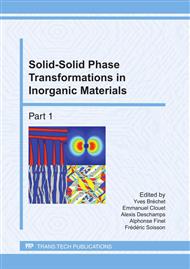p.525
p.539
p.549
p.555
p.561
p.567
p.573
p.579
p.585
A Mixed-Mode Model Considering Soft Impingement Effects for Solid-State Partitioning Phase Transformations
Abstract:
The original mixed-mode model is reformulated by considering the soft impingement effect and applying a general polynomial method of dealing with the concentration gradient in front of the interface. Comparison with the numerical solution shows that the reformulated mixed-mode model is more precise than the original model. The effect of soft impingement on the kinetics of partitioning phase transformation depends on both the growth mode and the degree of super-saturation.
Info:
Periodical:
Pages:
561-566
Citation:
Online since:
June 2011
Authors:
Keywords:
Price:
Сopyright:
© 2011 Trans Tech Publications Ltd. All Rights Reserved
Share:
Citation:


